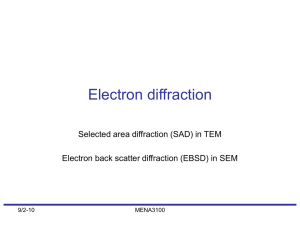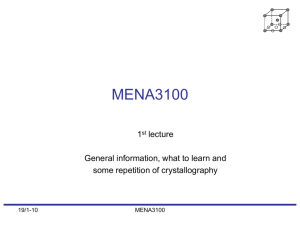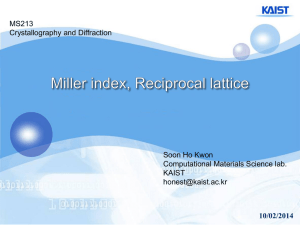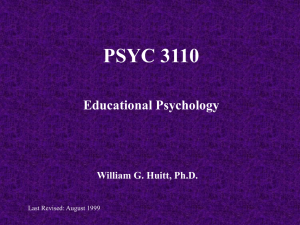Diffraction
advertisement
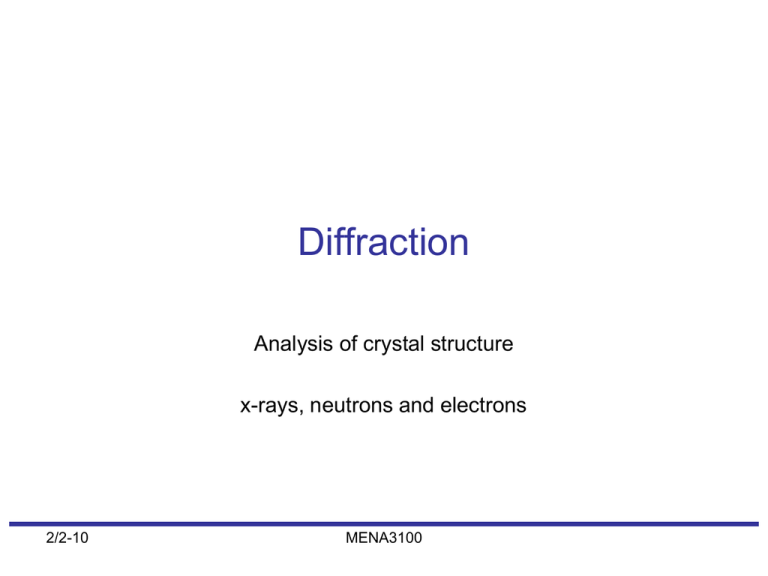
Diffraction Analysis of crystal structure x-rays, neutrons and electrons 2/2-10 MENA3100 The reciprocal lattice • g is a vector normal to a set of planes, with length equal to the inverse spacing between them g ha * kb * lc * • Reciprocal lattice vectors a*,b* and c* b c c a a b a* , b * , c * a (b c ) b (c a ) c (a b ) • These vectors define the reciprocal lattice • All crystals have a real space lattice and a reciprocal lattice • Diffraction techniques map the reciprocal lattice 2/2-10 MENA3100 Radiation: x-rays, neutrons and electrons • Elastic scattering of radiation – No energy is lost • The wave length of the scattered wave remains unchanged • Regular arrays of atoms interact elastically with radiation of sufficient short wavelength – CuKα x-ray radiation: λ=0.154 nm • Scattered by electrons • ~from sub mm regions – Neutron radiation λ~0.1nm • Scattered by atomic nuclei • Several cm thick samples – Electron radiation (200kV): λ=0.00251 nm • Scattered by atomic nuclei and electrons • Thickness less than ~200 nm 2/2-10 MENA3100 Interference of waves • Sound, light, ripples in water etc etc • Constructive and destructive interference =2n 2/2-10 2 1 ( x) sin( x) L 2 2 ( x) sin( x ) L =(2n+1) MENA3100 Nature of light • Newton: particles (corpuscles) • Huygens: waves • Thomas Young double slit experiment (1801) • Path difference phase difference • Light consists of waves ! • Wave-particle duality 2/2-10 MENA3100 Discovery of X-rays • • • • • Wilhelm Röntgen 1895/96 Nobel Prize in 1901 Particles or waves? Not affected by magnetic fields No refraction, reflection or intereference observed • If waves, λ10-9 m 2/2-10 MENA3100 Max von Laue • • • The periodicity and interatomic spacing of crystals had been deduced earlier (e.g. Auguste Bravais). von Laue realized that if X-rays were waves with short wavelength, interference phenomena should be observed like in Young’s double slit experiment. Experiment in 1912, Nobel Prize in 1914 2/2-10 MENA3100 Laue conditions (r ) Ae2ik r k 1 Scattering from a periodic distribution of scatters along the a axis ko a k The scattered wave will be in phase and constructive interference will occur if the phase difference is 2π. Φ=2πa.(k-ko)=2πa.g= 2πh, similar for b and c g hkl h a * k b* l c * 2/2-10 MENA3100 The Laue equations The Laue equations give three conditions for incident waves to be diffracted by a crystal lattice • • • Waves scattered from two lattice points separated by a vector r will have a path difference in a given direction. The scattered waves will be in phase and constructive interference will occur if the phase difference is 2π. The path difference is the difference between the projection of r on k and the projection of r on k0, φ= 2πr.(k-k0) If (k-k0) = r*, then φ= 2πn r*= ha*+kb*+lc* Δ=r . (k-k0) 2/2-10 MENA3100 Two lattice points separated by a vector r k0 r k Δ=a.(k-ko)=h (hkl) r*hkl Δ=b.(k-ko)=k Δ=c.(k-ko)=l k-k0 Bragg’s law • William Henry and William Lawrence Bragg (father and son) found a simple interpretation of von Laue’s experiment • Consider a crystal as a periodic arrangement of atoms, this gives crystal planes • Assume that each crystal plane reflects radiation as a mirror • Analyze this situation for cases of constructive and destructive interference • Nobel prize in 1915 2/2-10 MENA3100 Derivation of Bragg’s law sin( ) x θ d hkl x d hkl sin( ) θ θ dhkl x Path difference Δ= 2x => phase shift Constructive interference if Δ=nλ This gives the criterion for constructive interference: 2d hkl sin( ) n Bragg’s law tells you at which angle θB to expect maximum diffracted intensity for a particular family of crystal planes. For large crystals, all other angles give zero intensity. 2/2-10 MENA3100 Bragg’s law y • nλ = 2dsinθ θ – Planes of atoms responsible for a diffraction peak behave as a mirror d x θ The path difference: x-y Y= x cos2θ and x sinθ=d cos2θ= 1-2 sin2θ 2/2-10 MENA3100 von Laue – Bragg equation k0 θ k k g 1 g d hkl Vector normal to a plane 2ko g g 2 0 g k ko k 1 θ ko ko g ko g cos(90 ) ko g sin( ) ko k k ( k o k ) 2 k 2 2 k o 2k o k k 2 k 2 1 1 2k o k k 2 2 2 2k o k k 2 0 2/2-10 2ko g sin( ) g 2 1 1 2 sin( ) d hkl 2d hkl sin( ) MENA3100 The limiting-sphere construction • Vector representation of Bragg law • IkI=Ik0I=1/λ – λx-rays>> λe = ghkl Incident beam 2/2-10 MENA3100 The Ewald Sphere (’limiting sphere construction’) Elastic scattering: k k' k k’ The observed diffraction pattern is the part of the reciprocal lattice that is intersected by the Ewald sphere g 2/2-10 1 MENA3100 The Ewald Sphere is flat (almost) Cu Kalpha X-ray: = 150 pm => small k Electrons at 200 kV: = 2.5 pm => large k 2/2-10 MENA3100 50 nm 2/2-10 MENA3100 Allowed and forbidden reflections • Bravais lattices with centering (F, I, A, B, C) have planes of lattice points that give rise to destructive interference for some orders of reflections. y’y θ d x’ x θ – Forbidden reflections In most crystals the lattice point corresponds to a set of atoms. Different atomic species scatter more or less strongly (different atomic scattering factors, fzθ). 2/2-10 From the structure factor of the unit cell one can determine if the hkl reflection it is allowed or forbidden. MENA3100 Structure factors N X-ray: Fg Fhkl f j( x ) exp( 2i (hu j kv j lw j )) j 1 The coordinate of atom j within the crystal unit cell is given rj=uja+vjb+wjc. h, k and l are the miller indices of the Bragg reflection g. N is the number of atoms within the crystal unit cell. fj(n) is the x-ray scattering factor, or x-ray scattering amplitude, for atom j. wjc The structure factors for x-ray, neutron and electron diffraction are similar. For neutrons and electrons we need only to replace by fj(n) or fj(e) . z rj c a b v jb uj a y x The intensity of a reflection is Fg Fg proportional to: 2/2-10 MENA3100 Example: fcc • • • eiφ = cosφ + isinφ enπi = (-1)n eix + e-ix = 2cosx N Fg Fhkl f j exp( 2 i (hu j kv j lw j )) j 1 Atomic positions in the unit cell: [000], [½ ½ 0], [½ 0 ½ ], [0 ½ ½ ] What is the general condition for reflections for fcc? What is the general condition for reflections for bcc? Fhkl= f (1+ eπi(h+k) + eπi(h+l) + eπi(k+l)) If h, k, l are all odd then: Fhkl= f(1+1+1+1)=4f If h, k, l are mixed integers (exs 112) then Fhkl=f(1+1-1-1)=0 (forbidden) 2/2-10 MENA3100 The structure factor for fcc The reciprocal lattice of a FCC lattice is BCC What is the general condition for reflections for bcc? 2/2-10 MENA3100 The reciprocal lattice of bcc • Body centered cubic lattice • One atom per lattice point, [000] relative to the lattice point • What is the reciprocal lattice? N Fg Fhkl f j exp( 2 i (hu j kv j lw j )) j 1 2/2-10 MENA3100

